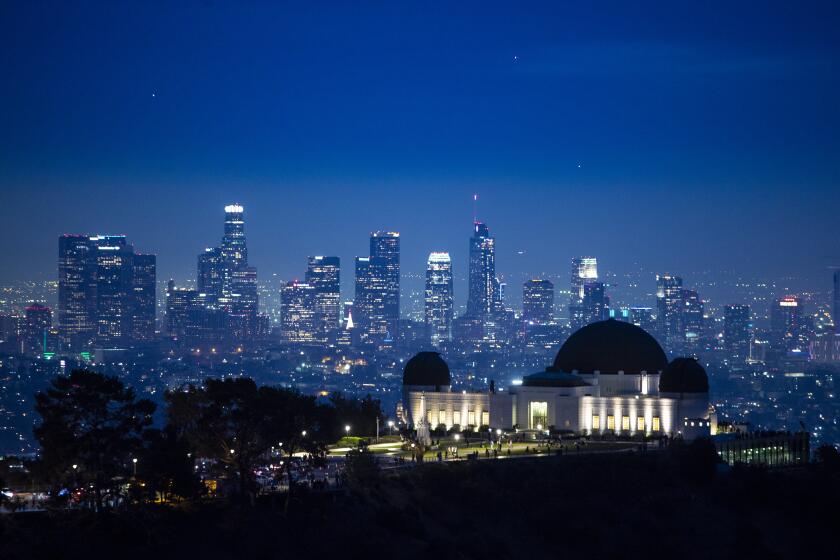‘Road Rage’ Still a Stubborn Highway Problem, CHP Says
- Share via
Earlier this month, the driver of an SUV, apparently upset that he had been cut off in traffic on the San Diego Freeway in Westchester, fired several shots at the other car, wounding the driver in the chest.
A few days earlier, a young college student riding in a car with a friend on a Bay Area interstate was shot and killed, apparently by another motorist who was steamed that the friend had honked at him for driving erratically. The incidents are grim reminders that violence on California’s freeways and state roads remains a stubborn problem six years after a spate of freeway deaths generated headlines of “road rage” and a congressional committee held hearings to consider ways to quell the problem.
Although news accounts of road rage and aggressive driving have subsided in recent years, violence has continued, mostly unabated, according to California Highway Patrol statistics. In fact, some roadway crimes -- such as shooting at an occupied vehicle and brandishing a gun -- have increased over the last five years, CHP records show.
“As long as people have tempers and drive cars, it’s going to be a problem,” said CHP spokesman Tom Marshall.
Authorities stress that not all roadway crimes fall into the category of road rage. Some highway crimes are motivated by gang rivalries and robberies, or other criminal acts.
Most law enforcement agencies, including the CHP, do not keep statistics on the motives behind such road crimes.
According to CHP crime reports, the number of incidents in which motorists have brandished firearms on freeways and state roads has increased from 26 in 1998 to 38 last year -- nearly one-half. During that period, use of freeways increased about 10%.
Reports of cases of reckless driving increased 18%, from 1,176 in 1998 to 1,391 last year. During that same period, the number of reported shootings into an occupied vehicle on a state highway or road jumped from seven to nine, the CHP said.
The number of incidents reported in which motorists tried to ram each other with vehicles on state highways or roads -- classified as assault with a deadly weapon -- increased by 3%, from 209 in 1998 to 215 last year, according to the CHP. The Los Angeles Police Department, which investigates serious crimes on freeways within the city’s borders as well as on city streets, does not keep separate statistics on roadway violence.
Still, officials said, anecdotal evidence suggests that there has been an increase in the number of incidents in recent months.
Los Angeles, for example, has been plagued by a spate of roadway shootings over the last six months, said an LAPD spokesman, Jack Richter. “It’s been more than the usual,” he said. “There have been literally dozens.”
LAPD Det. Kurt Wachter said he recalls about half a dozen car-to-car shootings in West Los Angeles in the last three years, including the San Diego Freeway shooting earlier this month.
In the same period, “we’ve probably had about 100 cases of vehicles striking each other” because of road rage, he said. “It’s aggravated assault, and we’ve been pretty successful in getting people prosecuted,” Wachter said.
Traffic safety experts attribute some of the frustration that sparks freeway violence to the increasing traffic congestion that forces motorists to spend more time behind the wheel.
Los Angeles County has earned the dubious distinction for the last 15 years of having the nation’s worst traffic congestion.
Arline Dillman, traffic safety manager for the Automobile Club of Southern California, said congestion is often just the last annoyance that triggers an angry outburst by a motorist who is already upset about more serious personal problems.
In most cases, motorists do not respond with violence or road rage, she said. More often, drivers become aggressive and respond to perceived slights by tailgating, speeding or changing lanes abruptly, Dillman said. “Often when we get into a car, it’s our personal space and we feel that other people shouldn’t infringe on our personal space,” she said.
Roadway conflicts sometimes turn deadly. On a Saturday evening in late November, Khoeun Kha, 23, of Long Beach was turning onto the narrow street where he lived when he nearly collided with a Toyota Cressida, said Det. Richard Birdsall of the Long Beach Police Department.
Even though a collision was avoided, witnesses told police that the driver of the Toyota pulled out a gun and fired several shots, hitting Kha in the upper torso. He died on the way to a hospital. No arrests have been made in the killing.
To avoid freeway confrontations, Dillman suggests that drivers allow themselves plenty of time to get to their destinations, avoid driving while angry and give other motorists plenty of space. “Don’t try to get into it with everyone,” she said. “It’s not a win-lose situation. Everyone loses.”
*
Times staff writer Hector Becerra contributed to this report.
More to Read
Sign up for Essential California
The most important California stories and recommendations in your inbox every morning.
You may occasionally receive promotional content from the Los Angeles Times.











